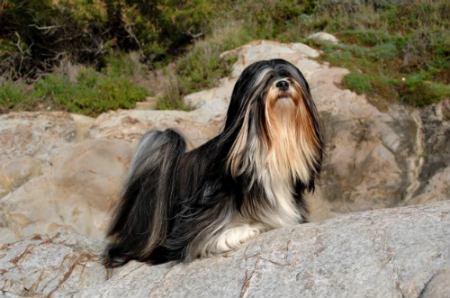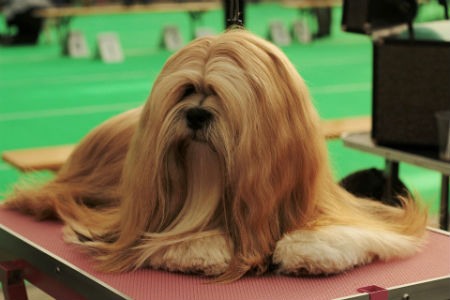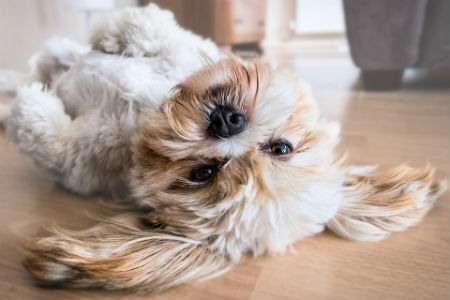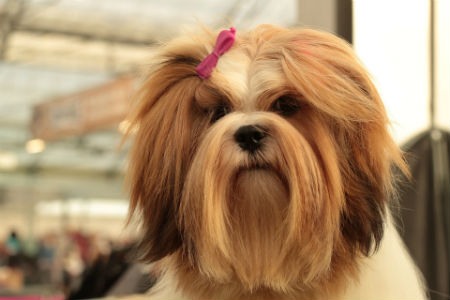LHASA APSO - A GREAT DOG IN A SMALL BODY
- Size: Little.
- Weight: Between 5 and 8kg.
- Hair type: Long and smooth.
- Character: Playful, assertive, intelligent, firm, devout, intrepid, friendly, energetic, vivacious, alert, obedient, energetic
- Health: Healthy
- Life expectancy: Between 12 and 14 years.
History and origin
If it is about mysticism, the origin of Lhasa Apso is undoubtedly covered with it. There are numerous theories that have been handled in terms of the history of this race. First of all, His name is associated with the city where he was known for the first time, Lhasa, in the Tibet, whose creation was destined to the shelter of the Tibetan temples, despite being a small race. In the monasteries of the aforementioned area, it was common to meet a dog of this breed performing surveillance and protection work, because their barking alerted the presence of intruders. In fact, these places were guarded abroad by mastines, while their interior by Lhasa Apsos.
PHYSICAL CHARACTERISTICS OF LHASA APSO
Lhasa Apso can be a misleading dog in relation to its appearance, because although it is a short -size animal, its body is robust and muscular, covered by a Extraordinary and abundant fur, especially his head.
Size and weight
So far, the FCI has not established a standard height and weight for this breed, so a slight variation has been seen normally in this aspect between the race. However, the average size for these dogs is 25 centimeters in males, while females, measure a little less (22 centimeters). Regarding weight, they can reach 7 to 8.5 kilograms, indistinctly their sex. Some may slightly exceed these measures.Head and face
A predominant physical appearance of Lhasa Apso It is the head, because it is abudently covered by its fur, similar to a lion, which seems to have a large skull. But it is not so. His skull is small and round. His eyes are black, oval, not very large. The nose is the color of his eyes, and small. While their ears, in a triangular and tiny way, fall slightly and are not easily observed because they are covered by the hair that covers all their frontal space.Contexture
The body of the Lhasa Apso race is small but very well formed, longer than tall. This is covered by two thick layers of its extensive fur. Its legs are short proportional to the body, but well planted, they facilitate mobility with great skill.Line
It is of high insertion and falls finely on your back. Like the rest of the body, it is covered by its extensive fur, with a very slight undulation on the tip, which can only be seen closely.Fur
He distinctive appearance of Lhasa Apso It is your fur. As mentioned in previous paragraphs, it is abundant throughout his body, with special pronunciation in his head, where he resembles a tiny lion. It is dense, thick and long. In his country of origin, Lhasa Apso fur was allowed to grow in a way that extended on the ground. However, at present, it is common to find domestic specimens with shorter hair.
Temper
It is a cheerful dog, although reserved in demonstrations of exaggerated affection, and also very independent. In general, The Lhasa Apso is little sociable, distrustful with unknown and jealous people in the presence of other animals. However, this will change as life shares with them. In general, coexistence is not a problem, if training from an early age, making special emphasis on socialization. It is an intelligent and very skilled dog, so your education will not be a problem.
Lhasa Apso training
The education of Lhasa Apso is elementary, because it is an independent dog that can be considered an "alpha" in the family. Training of these pets is not complicated. We talk about an intelligent and attentive dog, so it will be very easy to teach you orders if you start at an early age. Keep in mind that the training process must begin with socialization. It is elementary that the dog, from puppy, acquires practice in relation to this issue, if you want to live with other people and pets, without being aggressive or distrustful. Educating will allow it to be a balanced animal and behave well at home and in other places. Do not forget the importance of positive reinforcement. The dog will respond obedient and attentive to orders if rewarded during training and is treated with kindness. The opposite will happen if we try to train it for shouting or violently, because it can become rebellious and not training will be useless. After socialization, you can learn other orders that will be useful, and also tricks that can be very funny.Health
In general, this race enjoys a good state of health and a lot of energy. His longevity has become the longest, as he reaches almost 20 years of life. It is rarely affected by hereditary diseases, as is the case with hip dysplasia. On the other hand, they can be affected by some skin diseases, especially if it does not receive adequate bathroom and hygiene care in their fur. Renal problems and the appearance of ulcers are other evils that sometimes affect this race, but none of them are usually common and depend largely on the care they receive from their owners.Lhasa Apso care
We have reached one of the most important points of the article, and they are the care that must be taken into account if we want to adopt a dog Lhasa Apso. It is important to reiterate that This breed requires numerous care that must be rigorously fulfilled if you want to keep their beauty and good health. Let's look at the most elementary:
Hygiene
An essential aspect in maintaining this breed is hygiene, especially brushing. The Lhasa Apso requires that your fur is brushing at least once a day to avoid the appearance of knots that can mistreat their dense fur. The delicacy at the time of performing this procedure is important, otherwise your hair can be broken. You should get a bit moistened to avoid being broken and using a comb or soft brush. The use of special conditioner for high quality dogs is recommended, so that the brightness and silkiness of its fur can be maintained. The moment of the bath is the best to brush, because the hair is wet and thus avoid the appearance of knots. In relation to the bathroom, at least twice a month should be done.Feeding
Almost as important as hygiene, it is the food of the Lhasa Apso, as it is directly linked to the maintenance of its fur and in addition to its health in full. First, provide a quality feed, with an adequate amount of nutrients and also favor the brightness of your fur is essential for this breed to remain well cared for. On the other hand, food in small proportions, twice a day, will be enough for our friend to remain satisfied. The excessive use of snacks or awards is not recommended, because it can cause obesity in the dog.Exercises
This breed does not need an intense exercise routine. With a daily walk you can stay calm. It adapts to any space, so it will not be a problem if you live in an apartment or in the field.Vaccination and deworming
Maintaining adequate vaccine control, deworming and reviews with the veterinarian is also of the utmost importance. Well, in this way, you will receive the necessary medical care and remain free of diseases.Conclusion
In short, the Lhasa Apso dog is not a breed for anyone. Only who really has enough time to properly maintain the care of this dog, can enjoy your company. An eccentric and loyal animal is what defines these small specimens But great energy and beauty. A dog full of skills, ideal for hiking and as a company dog can be a great friend. Consider if it is the pet you need and, above all, if you have the time to take care of your health and enjoy your company. Articles we recommend:Share
